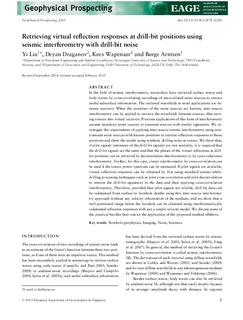| dc.description.abstract | In the field of seismic interferometry, researchers have retrieved surface waves and body waves by cross-correlating recordings of uncorrelated noise sources to extract useful subsurface information. The retrieved wavefields in most applications are between receivers. When the positions of the noise sources are known, inter-source interferometry can be applied to retrieve the wavefields between sources, thus turning sources into virtual receivers. Previous applications of this form of interferometry assume impulsive point sources or transient sources with similar signatures. We investigate the requirements of applying inter-source seismic interferometry using non-transient noise sources with known positions to retrieve reflection responses at those positions and show the results using synthetic drilling noise as source. We show that, if pilot signals (estimates of the drill-bit signals) are not available, it is required that the drill-bit signals are the same and that the phases of the virtual reflections at drill-bit positions can be retrieved by deconvolution interferometry or by cross-coherence interferometry. Further, for this case, classic interferometry by cross-correlation can be used if the source power spectrum can be estimated. If pilot signals are available, virtual reflection responses can be obtained by first using standard seismic-while-drilling processing techniques such as pilot cross-correlation and pilot deconvolution to remove the drill-bit signatures in the data and then applying cross-correlation interferometry. Therefore, provided that pilot signals are reliable, drill-bit data can be redatumed from surface to borehole depths using this inter-source interferometry approach without any velocity information of the medium, and we show that a well-positioned image below the borehole can be obtained using interferometrically redatumed reflection responses with just a simple velocity model. We discuss some of the practical hurdles that restrict the application of the proposed method offshore. | nb_NO |
